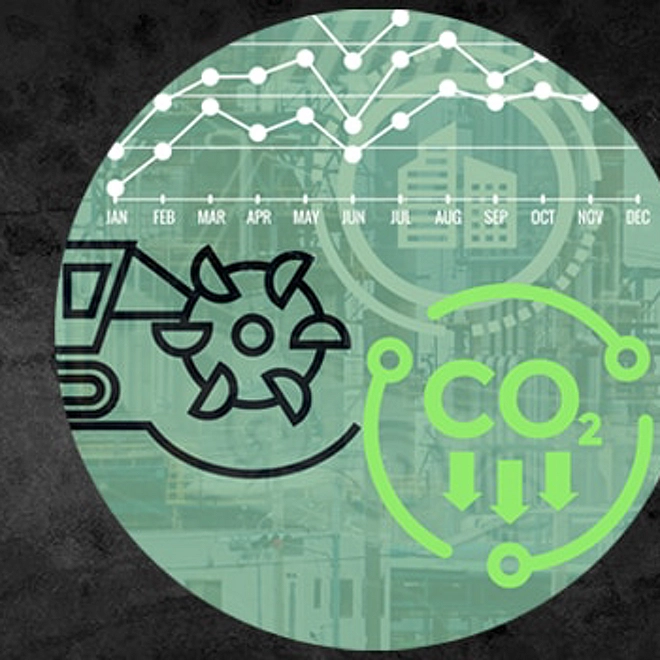Preparing operations for climate change
Managing physical risks through digital insights
Mining companies should prepare for the physical impacts a warming climate can produce across their businesses and operations as well as beyond their own sites.

Access the trend audiobook
Authors:
John O’Brien, Partner, Financial Advisory, Deloitte Australia
Patricia Muricy, Mining & Metals Leader, Deloitte Brazil
While decarbonization has been the primary focus of most miner’s climate change-related targets and investments thus far, mitigation is only one piece of the puzzle. Alongside these efforts, organizations need to be thinking ahead and building climate resilience across their businesses and operations.
Some tier one companies have begun to do this using United Nations climate models and digital risk-management tools to quantify both physical and transitional risks at new and existing mine sites. In some cases, these efforts even extend to scoping the exposure of their suppliers. But, for most mid-tier and junior miners, particularly those in geographical areas where climate impacts to date have been limited, this is unchartered territory.
However, in time, the effects of climate change will touch all businesses, across all sectors, regardless of their size and status. The level of transparency and integration of mining supply chains today means that organizations have the chance to prepare their own operations, and also help their suppliers and customers ready themselves for whatever operational effects a changing climate might bring.
Impacts of a warming climate
Physical risks resulting from climate change can be event-driven (acute) or longer-term shifts (chronic) in climate patterns. Both can carry financial implications for organizations, such as direct damage to assets and indirect impacts from supply chain disruption.
In certain geographies, extreme weather events such as droughts and flash floods pose a growing threat to mining activities as global temperatures rise. For example, BHP reported an 11% drop in output from one of its mines in New South Wales during 2019 due to poor air quality caused by bushfires.1 Scientists estimate that, if global temperatures rise by 2oC, the hot dry conditions that encourage bushfires would occur at least four times more often.2
Record heatwaves in North America during 2021 are another example. In June, temperatures in British Columbia reached 49.6 oC, breaking the country’s highest recorded temperature, and wildfires triggered evacuations in California and northern Nevada.3 This clearly has a significant effect on workers in the field.4
Organizations’ financial performance may also be affected by changes in water availability, sourcing, and quality, as well as issues around food security, and extreme temperature changes affecting premises, operations, and transport needs.
In their 2020 metals and mining survey, ‘Emerging ESG Risks in the Metals and Mining Value Chain’ Fitch Ratings and CRU named water scarcity as the greatest emerging risk to the mining and metals sector.5 The authors state: “Pressures such as localized water shortages and competition for water are likely to increase in the coming decades, causing increasing challenges for battery and low-carbon technology production.”
Most mining operations are heavily reliant on water for various purposes, including dust control, cooling of machinery, and mineral processing. Nowhere is this risk more evident than in copper. The increasingly arid conditions seen in northern Chile and southern Peru (the world’s largest copper-producing regions6) are forcing many large miners to invest in desalination plants. The Chilean Copper Commission (Cochilco) estimates that, by 2029, seawater will account for 43% of the water used in copper mining, up 230% on its expected level in 2018.7
In highly water-stressed areas, closed-loop extraction processes can help to lower abstraction requirements, and innovative tailings pond linings and coverings can reduce losses through seepage and evaporation. However, in areas where prolonged arid conditions are expected in the future, then dry processes and tailings storage solutions might be more sustainable in the long run.
Supply-chain vulnerability
For mining companies, the physical risks from climate change can extend much further than their own sites. For example, meteorological events have the potential to significantly disrupt key transport corridors.
In March 2021, heavy rain in Australia’s New South Wales and Queensland impacted global thermal coal supplies. Glencore was forced to cut capacity at some of its mine sites, while Yancoal suspended production at two of its open-pit mines.8 The Australian Rail Track Corporation temporarily ceased operations through parts of the Hunter Valley network due to localized flooding, a key transport corridor to the Port of Newcastle.9
Meanwhile, ship loading at the port was suspended for two weeks to repair storm damage to key equipment.10 This, plus flooding, caused Australian coal miner Whitehaven to slash its 2020-21 June−July coal production, and the number of vessels grew around port limits.11
Flooding and wet weather continued through the Australian summer, and supply issues saw thermal coal prices hit a record US$244.11 per ton on 8 October 2021.12 Floods were still affecting prime-production regions in November.13
While the cumulative effects of these disruptions are yet to be published, this example demonstrates why a collective and coordinated effort toward building climate resilience is required across the value chain.
Once again, digital tools can offer insights to support. Deloitte is currently helping a tier-one mining company assess operational risks posed by climate change across its supply chain using its Illuminate solution.14 This provides transparency of complex procurement networks by leveraging augmented intelligence and machine-learning methodologies to enable rapid modeling and represent those suppliers systematically. Multi-tier networks can then be overlaid with exposures and opportunities, including those related to climate-change risks.
Assess and prepare for different scenarios
In order to mitigate physical risks at both current operations and those under development, a detailed assessment under a variety of future scenarios is necessary.
John O’BrienꟷPartner, Financial Advisory, Deloitte Australia, explains: “If you’re building a mine today that’s going to be operating for 10, 20 or 50 years, it’s important to design the site, its infrastructure, and supply chain in a way that will mitigate the physical effects of climate change as far as possible.
Patricia MuricyꟷMining & Metals Leader, Deloitte Brazil “We know from global climate models what kind of changes will happen over the next 15 years under different scenarios ranging from 6oC to 1.5oC temperature rises. It’s only after 2035 that the trajectory of these models starts to diverge. The trajectory beyond 2035 is uncertain and will be determined by the speed of global decarbonization. Miners therefore need to build a certain level of agility and optionality into their operating plans.”
Quantify risks and opportunities
Deloitte Decarbonization SolutionsTM include an Adaptation/Physical Climate Risk Module that can demonstrate mining companies’ current and future exposure to various climate hazards for assets and portfolio locations. The module incorporates business and financial impacts and supports the translation of climate challenges along the value chain. It can also identify opportunities for investment and resilience and quantify climate thresholds for major disruptions. Alignment with Task Force on Climate-Related Financial Disclosures (TCFD) and other major climate risk frameworks helps to support climate risk disclosures, see figure1.
Figure 1: Physical Climate Risk Module: Providing quantification of physical risks globally

Source: Deloitte Decarbonization SolutionsTM
Based on data from these types of solutions, mining companies should instigate conversations with their suppliers, make decisions around future capital and resource allocation, and, where necessary, diversify their own supply chains to lower operational risks.
It’s reasonable to assume that consumers of critical minerals and metals, including electric-vehicle manufacturers and low-carbon energy technology providers, will soon be looking to do the same with their own supply chains. Mining companies play an important role in these both today and tomorrow. Where possible, miners should extend their climate risk-assessment exercises to the downstream portion of metal supply chains and encourage customers to ask questions about the future exposure and security of their suppliers. Security of supply is everyone’s concern, and preparedness could offer miners a competitive advantage compared with their peers.
Ultimately, organizations that build climate resilience will also gain access to more attractive financing, stronger employee recruitment and retention, and cheaper energy costs to name a few benefits.
Building climate-resilient mining and metals businesses
- Foster leaders for tomorrow: Building climate resilience across a business requires solid leadership. Leaders who steer resilient organizations share common traits: they are prepared, adaptable, collaborative, trustworthy and responsible.15 Companies should actively seek out individuals who exhibit these traits and build in measures to help train and retain them.
- Collaborate to accelerate: For all mining organizations, but, in particular, smaller and mid-cap miners, collaboration and sharing of experiences between peers can accelerate progress. Everyone is grappling with the same climate-related challenges and will benefit from shared experiences and solutions.
- Invest in business-wide capability: To lower operational risk from climate change requires greater awareness throughout organizations regarding the effects of climate change, and how basic decisions today could potentially set the business up for the future. Making physical climate risks a key talking point in the organization and site briefings will help to ensure continued visibility.
- Talk to your suppliers: Where possible, this awareness and commitment to lowering physical-risk exposure should also be extended to suppliers. This could be through formal communication or discussions with key personnel. Suppliers may even have measures in place already that could help mining companies lower their overall risk exposure.
- Question the value chain: It is important that mining companies challenge the physical resilience of supply chains they are involved in, both up and downstream. Consider how exposed off-takers and end consumers are, and also how the business and operations compare to peers and competitors in terms of readiness for a changing climate. As with any change, opportunities and threats will emerge. How miners prepare for disruption and communicate this to the markets could prove critical to their competitiveness and social license going forward.
End notes
1. Ben Chapman, “Australia wildfires: Mining firm BHP complains smoke is slowing down coal production,” Independent, published 21 January 2020 https://www.independent.co.uk/climate-change/news/australia-wildfires-smoke-bhp-coal-mining-new-south-wales-a9295151.html, accessed 15 November 2021.
2. Pallab Ghosh, “Climate change boosted Australia bushfire risk by at least 30%,” BBC News, published 4 March 2020 https://www.bbc.com/news/science-environment-51742646, accessed 15 November 2021
3. “US heatwave: California and Nevada brace for record-breaking temperatures,” BBC, published 10 July 2021 https://www.bbc.com/news/world-us-canada-57788118, accessed 14 December 2021
4. “Heat stress,” United States Department of Labor Mine Safety and Health Administration website https://www.msha.gov/sites/default/files/Alerts%20and%20Hazards/Heat%20Stress.pdf, accessed 14 December 2021.
5. “Water Scarcity Is Greatest Risk to Metals and Mining,” Fitch Ratings, published 8 July 2020 https://www.fitchratings.com/research/infrastructure-project-finance/water-scarcity-is-greatest-risk-to-metals-mining-08-07-2020, accessed 14 December 2021.
6. “Major countries in copper mine production worldwide in 2020,” Statista, published 2021 https://www.statista.com/statistics/264626/copper-production-by-country/, accessed 14 December 2021.
7. Camila Montes and Jorge Cantallopts, “Forecast for water consumption in the copper mining industry, 2018-2029,” Comisión Chilena del Cobre, published December 2018 https://www.cochilco.cl/Research/Forecast%20for%20water%20consumption%20in%20the%20copper%20industry,%202018-2029.pdf, accessed 14 December 2021.
8. Nathan Richardson and Eric Yep, “Floods in eastern Australia hit coal mining operations, supply chains,” S&P Global Platts, published 23 March 2021 https://www.spglobal.com/platts/en/market-insights/latest-news/coal/032321-floods-in-eastern-australia-hit-coal-mining-operations-supply-chains, accessed 14 December 2021.
9. Nathan Richardson and Eric Yep, “Floods in eastern Australia hit coal mining operations, supply chains,” S&P Global Platts, published 23 March 2021 https://www.spglobal.com/platts/en/market-insights/latest-news/coal/032321-floods-in-eastern-australia-hit-coal-mining-operations-supply-chains, accessed 14 December 2021.
10. Peter Ker, “Floods add to coal industry’s year of disruption,” Australian Financial Review, published 28 November 2021 https://www.afr.com/companies/mining/floods-add-to-coal-industry-s-year-of-disruption-20211128-p59cvg, accessed 14 December 2021.
11. Nathan Richardson and Eric Yep, “Floods in eastern Australia hit coal mining operations, supply chains,” S&P Global Platts, published 23 March 2021 https://www.spglobal.com/platts/en/market-insights/latest-news/coal/032321-floods-in-eastern-australia-hit-coal-mining-operations-supply-chains, accessed 14 December 2021.
12. Peter Ker, “Floods add to coal industry’s year of disruption,” Australian Financial Review, published 28 November 2021 https://www.afr.com/companies/mining/floods-add-to-coal-industry-s-year-of-disruption-20211128-p59cvg, accessed 14 December 2021.
13. Peter Ker, “Floods add to coal industry’s year of disruption,” Australian Financial Review, published 28 November 2021 https://www.afr.com/companies/mining/floods-add-to-coal-industry-s-year-of-disruption-20211128-p59cvg, accessed 14 December 2021.
14. “Illuminate,” Deloitte website, 2021 https://www2.deloitte.com/au/en/pages/technology/solutions/illuminate.html, accessed 14 December 2021.
15. “Building climate capability for a resilient mining sector,” Deloitte, 2021 https://www2.deloitte.com/au/en/pages/energy-and-resources/articles/building-climate-capability-resilient-mining-sector.html, accessed 14 December 2021



